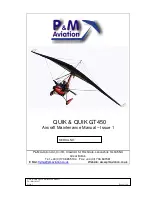
Savage Cub Australian Flight Manual © X-Air Australia 2008 Release 1.2 Page 26 of 40
SAFETY WARNINGS
Never prepare fuel in an area that is enclosed or where fumes could reach ignition point. DO
NOT SMOKE or allow open flames or sparks in the vicinity. Never add fuel while the engine
is running.
Never refuel an aircraft if fuel could be spilled on hot engine components or lexan. (
THE
LEXAN WILL CRACK IMMEDIATELY IN THIS CASE
)
Use only approved fuel containers and never transport fuel in an unsafe manner.
Always check for fuel contamination. Contamination is a major cause of engine failure. The
best place to avoid contamination is at the source. Once your fuel is in the container a very
hazardous potential exists. Use a clean safety approved storage container. Do not overfill the
container - allow for expansion.
The engine is designed for use with unleaded MOGAS, which has an Octane Rating of 98
RON or higher. Use aviation gasoline only for short period time and with carbon level
inspection. Be sure to use products of at least the standard shown in Section 1.
Always earth the aircraft through the Earthing Point provided at the fuel filler before removing
the fuel cap.
Before first flight of the day, and after each refuelling, use a sampler cup and drain a small
quantity of fuel from the fuel drain valve - check for water, sediment and contamination.
Filling the Tank
When fuelling from a pump to a full tank condition lift the nozzle out slightly for the last four
litres and slow the speed down as you can create a siphon motion that will dump the last four
litres out until the vent is above the fuel level. If this happens quickly remove the fuel cap to
break the siphon. (
TAKE CARE OF LEXAN!
)
Propeller Care
Full throttle run up over loose gravel is especially harmful to propeller tips. When takeoffs
must be made over a gravel surface, it is very important that the throttle is advanced slowly.
This allows the airplane to start rolling before high RPM is developed, and the gravel will be
blown behind the propeller rather than pulled into it. When unavoidable small nicks appear in
the propeller, they should be immediately fixed.
Noise Abatement
Increased emphasis on improving the quality of our environment requires renewed effort on
the part of all pilots to minimize the effect of airplane noise on the public.
As pilots, we can demonstrate our concern for environmental improvement by application of
the following procedures:















































